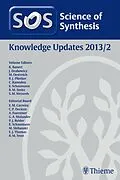"The Science of Synthesis Editorial Board,together with the volume editors and authors, is constantly reviewing the whole field of synthetic organic chemistry as presented in Science of Synthesis and evaluating significant developments in synthetic methodology. Four annual volumes updating content across all categories ensure that you always have access to state-of-the-art synthetic methodology. Content (published in July 2013):Organometallic Complexes of Nickel, High-Valent Palladium in Catalysis, Disilanes and Oligosilanes, Silylzinc Reagents, Silylamines, Silyl Phosphines, ß-Silyl Carbonyl Compounds, Seven-Membered Hetarenes with Two or More Heteroatoms, Cyanogen Halides, Cyanates and Their Sulfur, Selenium, and Tellurium Analogues, Sulfinyl and Sulfonyl Cyanides, Cyanamides, and Phosphaalkynes, Seleno- and Tellurocarbonic Acids and Derivatives, Arylphosphines and Derivatives, Alkaneselenols, Alkaneselenolates of Group 1, 2, and 13-15 Metals, Substitution on the Amine Nitrogen "
Zusammenfassung
Science of Synthesis is a reference work for preparative methods in synthetic chemistry. Its product-based classification system enables chemists to easily find solutions to their synthetic problems.
Key Features:
- Critical selection of reliable synthetic methods, saving the researcher the time required to find procedures in the primary literature.
- Expertise provided by leading chemists.
- Detailed experimental procedures.
- The information is highly organized in a logical format to allow easy access to the relevant information.
The Science of Synthesis Editorial Board, together with the volume editors and authors, is constantly reviewing the whole field of synthetic organic chemistry as presented in Science of Synthesis and evaluating significant developments in synthetic methodology. Four annual volumes updating content across all categories ensure that you always have access to state-of-the-art synthetic methodology.
